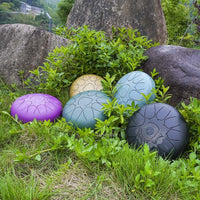Handpan is a musical instrument born from the workshops of PanArt, a Swiss company directed by Felix Rohner and Sabina Shärer. The Handpan, then called Hang by its designers, in reference to "the hand" in German-speaking Switzerland, finds its filiation in the Ghatam.
This is the reason why the Handpan is also called Hang Drum. Today, it is available for sale from many companies, such as ZenaPan, which offers the best handpans tuned in D minor.
The Indian roots of the Handpan
The Ghatam, also called Ghara, derives its etymology from its primary function: to be a "water pot". The Ghatam is in fact nothing more or less than a clay water pot. Used in a roundabout way since the 8th century, it inspired the invention of a metal Ghatam, which became the Handpan.
This dream of a percussion instrument made of metal and capable of producing different notes is that of Reto Weber who, in 1999, gave the idea to the company PanArt to create this brand new instrument.
The success was dazzling. The futuristic-looking New-Age instrument was immediately integrated into its century and found a passionate clientele. However, the momentum of the PanArt company was to be short-lived.
After the euphoria of the creation, the trials
Put on the market by the PanArt company in 2000, the Hang was withdrawn from sale in stores in 2005, PanArt wanting to limit itself to direct sales, and only on motivated request. To the point that instruments are becoming rare and that the demand largely exceeds the offer.
Musicians have to queue up to buy one, and travel to Bern to purchase it, under cover of PanArt's right of resale, which prohibits the sale of instruments for profit.
As nature abhors a vacuum, the Hang manufacturers, who then became Hang drum, quickly multiplied. In its desire to control the entire industry, PanArt had created competing companies capable of meeting the growing demand.
Targeting copyright laws, PanArt engaged in legal disputes of all kinds, trying to prohibit the manufacture of its instrument by other firms, both in the United States and in Europe, with important victories, such as against the Dutch company Ayasa.
A new type of instrument making
The emergence of new production workshops, nearly 300 throughout the world, gave rise to a new instrumental quality. A multiplication of sonorities was born. New musical associations were born.
The lawsuits, which have deeply destabilized the Ayasa company, ordered by the Dutch court to stop production, have raised protests among all percussionists.
The very image of the company PanArt was damaged, and the question was raised whether Felix Rohner and Sabina Shärer were not trying to impose a legal monopoly on the Hand pan, arguing that their work had been distorted.
The fact remains that the handpan has developed and that nothing can stop it from doing so. The Handpan has entered the great family of musical instruments, like the violin, the saxophone or the harp, and nothing can stop musicians from owning and playing this magnificent instrument.
Start playing music yourself and buy your first handpan.







